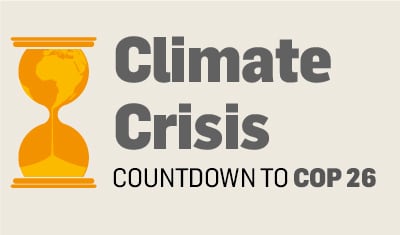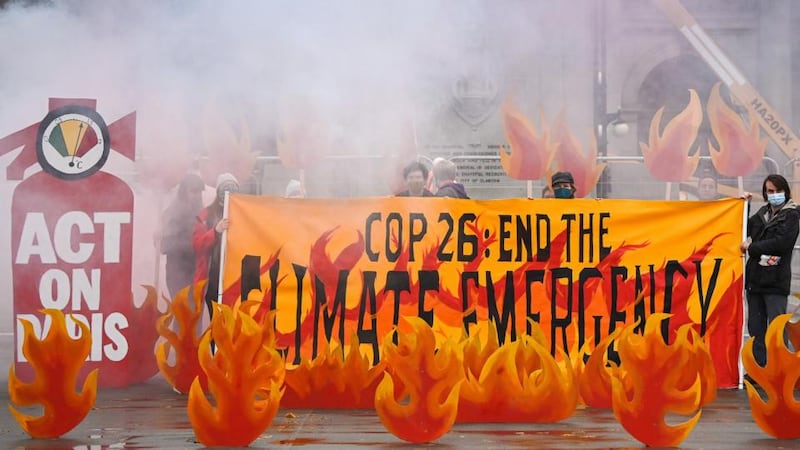It is set to be the biggest political meeting in British history and one of the most important, with more than 100 world leaders and 25,000 other attendees arriving in Glasgow from Sunday for two weeks of talks to save the planet's future. But the mood around Cop26 is increasingly downbeat and a little anxious so that even Boris Johnson abandoned his standard boosterism this week to voice a note of caution.

“Cop26 is both unbelievably important for our planet but also very difficult. It is in the balance,” he told MPs.
Queen Elizabeth has pulled out of opening the summit because of ill health, joining China's Xi Jinping, Russia's Vladimir Putin and Pope Francis among the no-shows. Within the British government, rivals are whispering against the summit's president, Alok Sharma, blaming the former business secretary's low-key style for failing to extract more climate change commitments from other governments.
Even the summit’s mascot, Bonnie the Seal (recycled from the 2018 European championships), is under attack, with the Daily Telegraph quoting a government official as saying it looked more like a rat than a seal. Some in Glasgow think a rat would be an appropriate mascot for their city, which saw its rodent population grow alarmingly during the coronavirus lockdowns.

It's not something that is unique to Glasgow. All cities <br/> have rats
Glasgow City Council leader Susan Aitken this week played down the scale of the problem, along with reports that council workers had been hospitalised after being bitten by rats.
“There was I think one, possibly two, small incidents where an employee... where there was a health and safety incident and they were taken as a precaution to hospital for a very minor contact with a rat,” she said. “It’s not something that is unique to Glasgow. It is something that is happening right across the UK. All cities have rats.”
All these controversies will be forgotten if Johnson can persuade his fellow leaders to make binding commitments to take the steps necessary to reach the goals they agreed on in Paris in 2015. Chief among these was to limit global warming to between 1.5C and 2C by the middle of this century.
Success depends on all countries reaching net zero emissions – ensuring that the amount of greenhouse gases produced is no greater than the amount removed from the atmosphere – as soon as possible. Each country has to produce its own national plan to reach the target and Johnson hopes that the ambition of Britain’s strategy will give him the credibility to persuade others to take similar steps.
The UK is among the most ambitious countries in the world in terms of its net zero by 2050 target
Published last week, the 368-page plan is among the most ambitious and detailed of any major industrialised country, setting out how Britain will reach net zero by 2050.
"The UK is among the most ambitious countries in the world in terms of its net zero by 2050 target. And it's a legally binding goal, which is not the case for the majority of countries with net zero goals. There are some countries, such as Germany which has a 2045 target that is slightly more ambitious, and some smaller Nordics have got even earlier goals. But in terms of major economies, the UK's right up there," says Simon Evans, policy editor of Carbon Brief (carbonbrief.org), a British website covering climate science and policy.
“This net zero strategy means the UK now has a quite serious set of ambitions, phasing out combustion cars by 2030, sales of new ones, an ambition to end the sale of gas boilers by 2035, and an ambition for the electricity system to be fully decarbonised also by 2035. Those are serious ambitions. We shouldn’t pretend otherwise. As to whether there are credible policies to get us there, I think there are definitely gaps and some of the proposals aren’t yet fully fleshed out.”

Under the plan, car manufacturers will have to sell a rising share of electric vehicles each year and companies selling gas boilers for home heating will have to sell a rising share of heat pumps. No new petrol or diesel cars and vans will be sold after 2030 and all new heating system installations will have to be low carbon by 2035.
Heat pumps work like a reverse air conditioner, absorbing heat from the air outside into a liquid refrigerant which is then compressed to increase the temperature and condensed to release heat for radiators and hot water tanks. They cost about £10,000 each and the government will offer £5,000 to households who switch from gas boilers.
Britain has dramatically cut its dependence on fossil fuels for electricity in recent decades and the net zero plan says that all electricity should come from low carbon sources. Apart from investing in offshore wind, Britain will explore new nuclear power options.
It's very reliant on the prime minister's particular whims. Last week was a week where he was very interested in it. There are lots of weeks where he's not
Planting more trees will help to remove greenhouse gases from the atmosphere but Britain is also banking on carbon capture and storage to offset emissions. This involves separating and capturing carbon dioxide from other gases before it enters the atmosphere and converting it into liquid to be transported and pumped deep underground for permanent storage.
The net zero strategy includes five-yearly targets and an independent Climate Change Commission monitors the government's progress. But Tom Sasse, associate director at the Institute for Government think tank, warns that delivering policies involving huge numbers of actors across different departments will be very difficult.
“Essentially, you need a kind of powerful mechanism in government to bring together lots of different policies in different sectors and make sure they line up and make sure they stay on track and, if they’re not on track, to work out what the delivery issues are and unblock those. And we’ve seen previous examples in the Olympics, for example, where we had central units, an Olympics delivery agency, and so on for doing that within government,” he says.
"It's very reliant on the prime minister's particular whims. Last week was a week where he was very interested in it. There are lots of weeks where he's not. He's committed to it, which does matter. I think what also matters from a delivery perspective is having a prime minister rather like Tony Blair with his hospital and education targets and so on, who would sit there with his delivery unit, who would haul the department in week after week after week and say 'Why are you missing X target and what are you going to do about it?' – actually get into the detail of the policy. I think that's what we haven't got on net zero."
They will deliver benefits but there'll also be costs. Some of those costs are going to hit some people more heavily
Sasse says the plan is very optimistic about the capacity of technology, warning that if things go wrong, the government could be tempted to pile more emissions into its carbon capture assumptions. He believes one key question is the extent to which the government is transparent about the progress it is making, noting that the plan does not specify exactly what emissions reduction each policy is expected to deliver.
Alongside the net zero strategy, the treasury published a paper warning that the changes needed to reach the target could not be funded by borrowing. Sasse says that chancellor of the exchequer, Rishi Sunak, may have political reasons to distance himself from Johnson's climate change agenda but he believes the treasury is offering a useful corrective to the prime minister's relentless optimism.
“There are clearly lots of people, on the Conservative back benches particularly, whose big concern is the cost. And the cost has almost become a kind of socially acceptable way of expressing climate scepticism. But actually if you dig into the treasury document, it is much more interesting than that,” he says.
“It does pour a little bit of cold water on some of the kind of Johnson boosterism, as it were. The prime minister wants to say this is all just a good news story – more innovation, more jobs, richer, cleaner, etcetera. And the treasury wants to say, some of these are quite difficult changes. They’re going to cost money upfront. They will deliver benefits but there’ll also be costs. Some of those costs are going to hit some people more heavily. And they’ll also make useful points, like actually if we decide to make investments in low carbon infrastructure, it means we can’t make investments in other things that we might have wanted to. That’s a very treasury type of point to make, but it’s absolutely true.”










